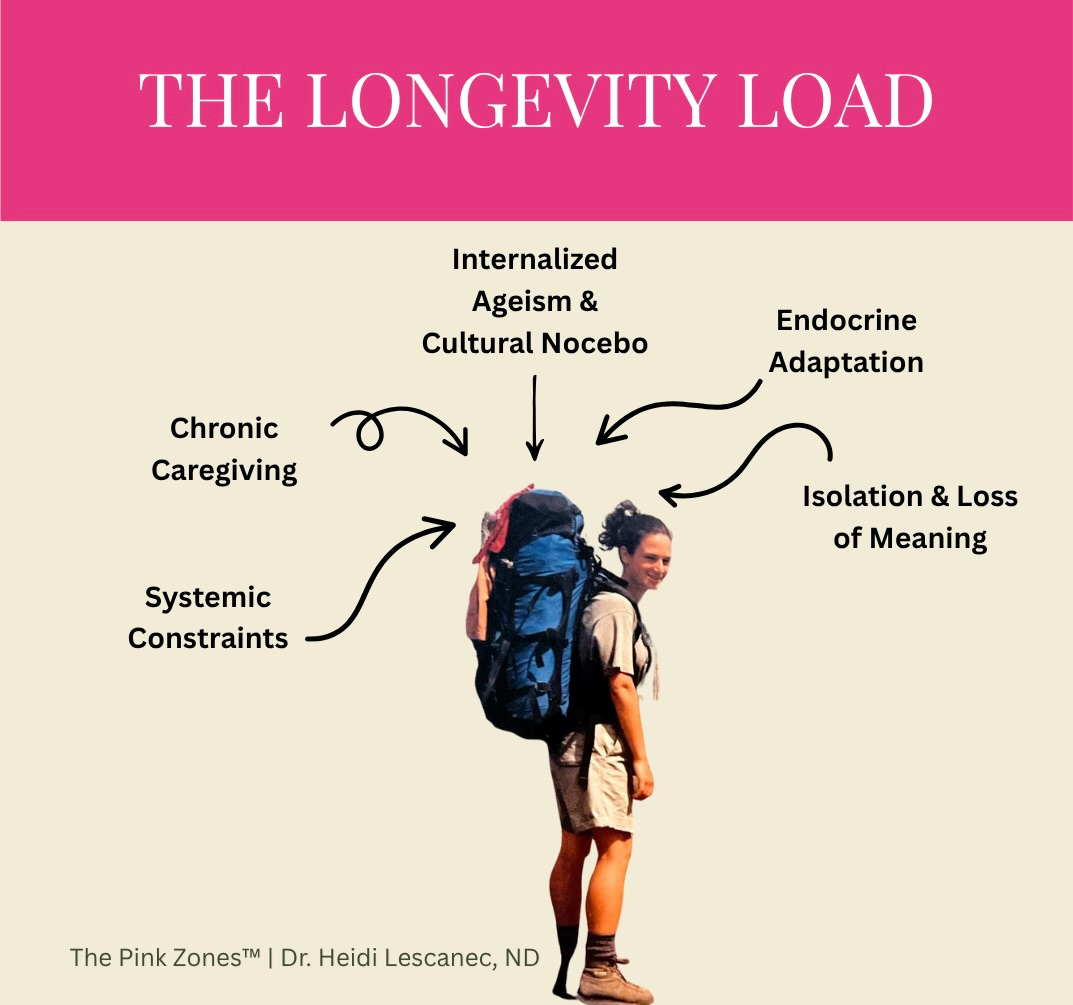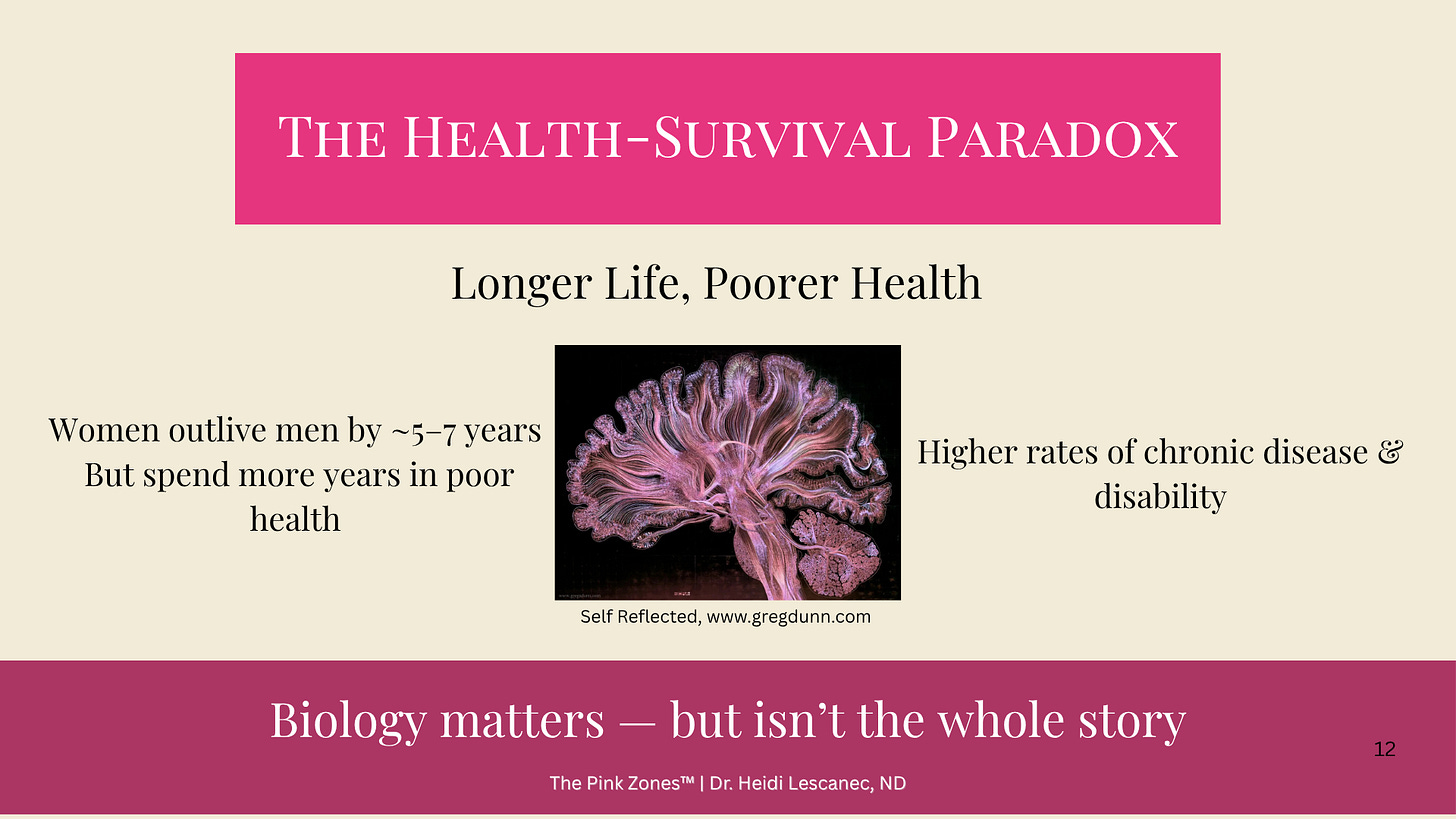The Longevity Load
Naming What Women Have Been Carrying All Along
You’ve probably heard it: “Become the CEO of your health.”
It sounds empowering. But what if the boardroom is already crowded—every seat taken by invisible burdens?
How can we ask women to take charge of their health without first naming what has been steering it for years?
This is what I call The Longevity Load: the hidden, cumulative stress women shoulder in midlife. It’s the biological, emotional, cultural, and systemic weight that medicine and wellness models too often ignore.
And until we name it, we can’t begin to lighten it.
This also brings us to the Health Longevity Paradox…
Women typically live longer than men, in many countries by five to seven years.
But those extra years are not necessarily healthy ones.
Women are more likely to live with chronic disease, disability, and distress across midlife and later life. See this recent systematic analysis published in The Lancet Public Health (2024), citation below.
The truth is: women carry a heavier Longevity Load than men, and for a longer time.
This distinction matters. And it’s exactly what makes the Pink Zones different from the Blue Zones.
To create real health—to foster more Pink Zones, conditions that allow women not just to live longer but to thrive—we must first name the load. Only then can we co-create the pillars that lighten it and make thriving possible.
What Makes Up the Longevity Load
The Hidden Drivers of Midlife Distress
The Longevity Load is made up of invisible, often unspoken stressors that chip away at wellness, no matter how many supplements, green smoothies, or breathwork sessions we stack on top.
1. Internalized Ageism & the Cultural Nocebo
Women are taught, subtly and overtly, that their value declines after 40.
These beliefs don’t just wound self-esteem; they affect physiology, mood, libido, even immune function. Many enter perimenopause expecting to suffer, and healthcare experiences often confirm it.
This is what I call the Cultural Nocebo: when a negative belief about an experience creates real, measurable harm.
You’ve heard about power of the placebo effect?
Positive expectations improve outcomes. Its darker twin, the nocebo effect, is lesser known. It happens when negative expectations worsen symptoms or even trigger new ones.
Take menopause. Women today are conditioned to expect a fiery descent: hot flashes, mood swings, sleepless nights—with nothing ahead to look forward to but aging. And aging, by the way, is something we’re told to resist at all costs—both facially and financially. But what if those very expectations are shaping women’s experience?
What if the nocebo effect is amplifying discomfort—not because suffering is inevitable, but because women are told it is?
This narrative runs deep—baked into media, marketing, products aimed at fears of losing youth, and everyday jokes and endless reels about “falling apart.”
*Personal aside: I was at an intimate dinner recently, speaking about an injustice, when another woman interrupted me, saying (not ironically): “You’re flaring up your angry 11s.”
That’s how deep the fear narrative goes: women (unknowingly?) policing women, reducing righteous anger to a wrinkle. Even our faces are framed as liabilities. This is how patriarchy feeds the cultural nocebo—convincing us that #1, expressing a valid emotion is risky, and #2, it might also come (gasp) with a facial cost.
2. Chronic Caregiving & Invisible Labor
Women are conditioned to care—for children, partners, parents, workplaces, communities. Their own needs come last. Over decades, this constant giving erodes not only energy but identity.
As Ashton Applewhite notes: “Entire clinical empires rise around diseases like Alzheimer’s, while the caregiver crisis remains invisible.”
I have so much to say about this from lived experience and amazing activism and change-making in this realm. I will share more in my upcoming article on Systemic Support Pillar #5.
3. Systemic Constraints
Time, money, safety, and freedom aren’t equally distributed. Wage gaps, underfunded maternal care, and restricted bodily autonomy—all shape whether women can access real self-care. These aren’t personal failures. They are systemic limitations that directly impact women’s health.
A woman’s access to “real” self-care is dictated by the systems she lives within—economic, racial, geographic, and political. These constraints determine whether she can access cortisol-lowering practices like movement, rest, nature, socialization, or creative expression.
Many male wellness gurus speak about health optimization as if freedom is a given. Many women don’t have that.
Wellness, especially for women, doesn’t happen in a vacuum.
Health happens in the context of childcare, income, community safety, access to time, and how we are seen by our culture.
That’s why the Pink Zones remind us: thriving isn’t only personal—it’s political. From the caregiver crisis to laws that protect women in the workplace, these structures matter.
One of the first articles I ever published—for Katie Couric Media—was called The Last Workplace Taboo: Why Menopause Deserves a Seat at the Table. Because menopause isn’t just a personal journey. It’s also a workplace, cultural, and political issue.
4. Endocrine Adaptation
Hormonal shifts in perimenopause and menopause aren’t pathologies—but without support and accurate information, they become distressing. Sleep disruption, brain fog, mood swings, weight changes are real adaptations. Too often they’re dismissed, misdiagnosed, or pathologized.
Here’s the bigger picture: yes, hormones shift. But hormones never act in isolation. They always interact with context. And it’s at this intersection—hormones and life load—where women’s mood, energy, and health are truly shaped.
Think about when perimenopause arrives: often in a woman’s 40s, right as she’s balancing career, caregiving, aging parents, and an endless mental load. By then, reserves are thin. Self-care has been pushed aside. Her body isn’t breaking down—it’s asking for attention.
The menopause transition is an inflection point. To adapt in any transition, we need recalibration. If a woman enters midlife depleted or burned out, her experience will be very different.
5. Isolation & Loss of Meaning
As roles shift—children leave, careers plateau, parents pass—many women experience shrinking circles and a loss of identity. How many midlife women have you heard say they just don’t feel like themselves anymore?
Without ritual, purpose, or cultural frameworks for eldering, this stage of life can feel like a slow erasure. This erosion of meaning increases risk for chronic disease, cognitive decline, and emotional distress—but is rarely named in medical models.
It’s time to turn this around. This is why I started the Pink Zones Podcast Club. I invite you to join (details below).
Why Naming Matters
Supplements, green smoothies, meditation apps—none of these can erase the unspoken weight women carry. If we truly want women to be the CEOs of their health, we must clear space in that boardroom by recognizing the Longevity Load.
Naming it is the first step. Then, can we move from survival to transformation.
Looking Ahead: From Load to Liberation
This is where the Pink Zones Pillars come in. Unlike the Blue Zones (known for all ideal lifestyle and diet guidelines that you well know already and naturopathic medicine has been recommending for over a hundred years), the Pink Zones are about creating conditions that allow women to flourish, even in the midst of challenges and transitions.
In an earlier piece, The Hunt for the Pink Zones, I shared the seven pillars that make these zones possible. Over the next few weeks, I’ll be unpacking each one—showing how we can not only recognize what women are carrying, but also build spaces, practices, and communities that lighten the load.
Because women don’t just deserve longer lives.
We deserve healthier, fuller, joyful ones.
Reference
Differences across the lifespan between females and males in the top 20 causes of disease burden globally: a systematic analysis of the Global Burden of Disease Study 2021
Patwardhan, Vedavati et al. The Lancet Public Health, Volume 9, Issue 5, e282 - e294
Ready to lighten the Longevity Load?
Or maybe you just need stronger pillars beneath you?
Join the Pink Zones Podcast Club and let’s do it together.
Many women I know are tired of being told that midlife is a time full of more problems to fix.
What we really want is depth: health that feels real and bone deep, connection that sustains us, and wisdom that helps us grow into this stage of life with strength and joy.
That’s what the Pink Zones Podcast Club is about.
Each month, we listen to two thought-provoking podcast episodes on themes that matter for women in midlife and beyond: vitality, meaning, belonging, resilience, and creativity. Then we gather, not for small talk, but for meaningful conversation that helps us integrate these insights into daily life.
It’s just like a book club, but with podcasts.
You’ll listen at your own pace, then join on Zoom for rich conversation, shared wisdom, and practical takeaways.
This is a chance to step out of the fix-yourself culture and into community.
Together, we’ll have a good time discovering what it means to create more Pink Zones — the places and conditions where women flourish.
Thursday, October 23
Thursday, November 13
Thursday, December 11
Time: 5:30 PM PT / 8:30 PM ET (1-hour sessions)
Where: Zoom (link provided upon registration)
*Paid Subscribers join for free!*















Thank you for explaining this concept. I look forward to reading more of your articles.
Love the framing of the Longevity Load. Systems matter so much